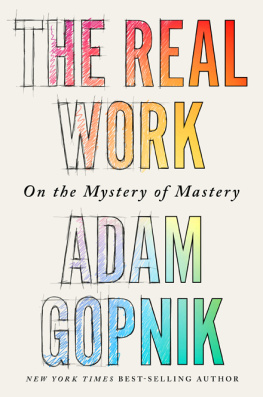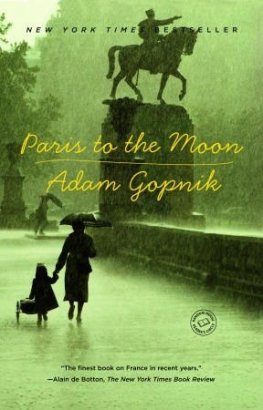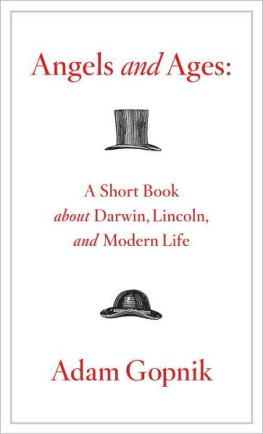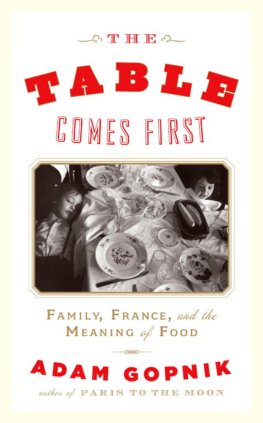
THE
REAL
WORK

On the Mystery
of Mastery
Adam Gopnik

Liveright Publishing Corporation
A Division of W.W. Norton St Company
Celebrating a Century of Independent Publishing
For everyone who teaches, and anyone wholl learn
And in continuing memory of the greatest teacher Ive ever known, or will know, Kirk Varnedoe
ALSO BY ADAM GOPNIK
A Thousand Small Sanities:
The Moral Adventure of Liberalism
In Mid-Air:
Points of View from over a Decade
At the Strangers Gate: Arrivals in New York
The Table Comes First
Winter: Five Windows on the Season (The CBC Massey Lectures)
Angels and Ages
The Steps Across the Water
Through the Childrens Gate: A Home in New York
The King in the Window
Paris to the Moon
Americans in Paris: A Literary Anthology (editor)
High and Low: Modern Art and Popular Culturer (with Kirk Varnedoe)
Musical Theater
Our Table (music by David Shire)
Sentences (music by Nico Muhly)
D OING BEGINS BY DOUBTING. THATS ONE OF the great lessons we inherit from the scientific tradition. So before we start to do, let us start to doubt. And we can doubt by considering the case of one of the great doubt-provokers of the Enlightenment: the Turk. It was, as you may know, the first great automatona chess-playing machine that inflamed Europe in the late eighteenth century. That it was not actually an automaton and couldnt play chess didnt alter the effect it had on people at the time. Like many others, I have been fascinated by the Turk since I first read about it, in histories of magic and illusion. Then Tom Standages fine 2002 horizontal social history of the machine and its times, called, simply, The Turk, clarified an often deliberately mystified history.
The Turk first appeared in Vienna in 1770 as a chess-playing machinea mechanical figure of a bearded man dressed in Turkish clothing, seated above a cabinet with a chessboard on top. Its inventor and first operator, a Hungarian quasi-nobleman, scientist, and engineer named Wolfgang von Kempelenone of those amazing Enlightenment figures who danced at eight weddings at once and still kept the beatwould assemble a paying audience, open the doors of the lower cabinet, and show the impressively whirring clockwork mechanisms that filled the inner compartments beneath the seated figure. Then he would close the cabinet and invite a challenger to play chess. The automatonthe robot, as we would say nowwould gaze at the opponents move, ponder, then raise its mechanical arm and make a stiff but certain move of its own. Mastery had been implanted in it; a computer, a living brain, had been taught somehow to play chess!
Before it was destroyed by fire in Philadelphia in the 1850s, the Turk toured Europe and America and played games with everyone from Benjamin Franklin to, by legend at least, Napoleon Bonaparte. It certainly once played a game with Philidor, the greatest chess master of the age. The Turk lost, but Philidor admitted that he had been hard-pressed to defeat it, a public relations triumph for Kempelen. Artificial intelligence, the eighteenth century believed, had arrived, wearing a fez and ticking away like Captain Hooks crocodile.
Of course, the thing was a fraud, or rather, a tricka clever magicians illusion. A sliding sled on well-lubricated casters had been fitted inside the lower cabinet and the only real ingenuity was how this simple machine allowed a hidden chess player to glide easily, and silently, into a semi-seated position inside. There was a lot more room to hide in the cabinet than all that clockwork machinery suggested.
Now, the Turk fascinates me for several reasons, since it illuminates many odd and haunting holes in human reasoning and in our response to mastery. It reminds us, in Ottoman garb, that mastery is, among other things, a performance, and one that depends on our guesses, confident or not, about the identity of the master were watching.
The first truth it embodied is that, once impressed, we quickly leave the ladder of incremental reasoning behind. Common sense should have told the people who watched and challenged it that for the Turk to have really been a chess-playing machine, it would have had to have been the latest in a long sequence of such machines. For there to be a mechanical Turk who played chess, there would have had to have been, ten years before, a mechanical Greek who played checkers. Its true that the late eighteenth century was a great age of automatons, machines that could make programmed looms weave and mechanical birds sing although always the same song, or tapestry, over and over. But the reality that chess-playing was an entirely different kind of creative activity seemed as obscure to them as it seems obvious to us now.
People were fooled because they were looking, as we always seem to do, for the elegant and instant solution to a problem, even when the cynical and ugly and incremental one is right. The great-grandfather of computer science, Charles Babbage, saw the Turk, and though he realized that it was probably a magic trick, he also asked himself what exactly would be required to produce an elegant solution. What kind of machine would you actually have to build if you could build a machine to play chess? What would its capacities need to be? Babbages difference engine the first computerarose in part from his desire to believe that there was a beautiful solution to the problem of what we now call artificial intelligence, even if the one before him was not it.
We always want not just the right solution to a mystery; we want a beautiful solution. And when we meet a mysterious thing, we are always inclined to believe that it must therefore conceal an inner beauty. When we see an impregnable tower, we immediately are sure that there must be a princess inside. Doubtless there are many things that seem obscure to usthe origins of the universe, the nature of consciousness, the possibility of time travelthat will seem obvious in the future. But the solutions to their obscurity, too, will undoubtedly be clunky and ugly and more ingenious than sublime. The solution to the problem of consciousness will involve, so to speak, sliding sleds and hidden chess players.
BUT THERE is another aspect of the thing that haunts me too. Though some sought a beautiful solution when a cynical one was called for, plenty of peopleEdgar Allan Poe, for instance, who wrote a long analytic piece on the machine when it toured America, one of his first significant published worksrealized that the Turk had to be what it actually was, a cabinet with a chess player inside. What seems to have stumped Poe and the other, shrewder Turk detectives was not the ugliness of the solution but the singularity of the implied chess player. Where would you find a tiny chess genius, they wondered. Or could the operator be using fiendishly well-trained children? Even if you accepted the idea of an adult player, who could it be, this hidden, inscrutable but unquestionable master?
It turns out that the chess players who operated the Turk from inside were just... chess players, an ever-changing sequence of strong but not star players, who needed the gig badly enough to be willing to spend a week or a month working sessions inside its smoky innards. Kempelen, and then after him a traveling showman named Maelzel, who bought and restored the automaton and took it to America, picked up chess players wherever they happened to be, as Chuck Berry used to hire his backup bands on the road. In Paris, when the Turk played Philidor, Kempelen recruited a variety of strong but second-rank chess players from places like the Caf de la Rgence, the leading chess caf in a city where coffeehouse life had bloomed to become a separate civil society of its own. They included a surprisingly tall player named Boncourt; a chess writer named Alexandre; and a now completely unknown chess player named Weyle.
Next page







